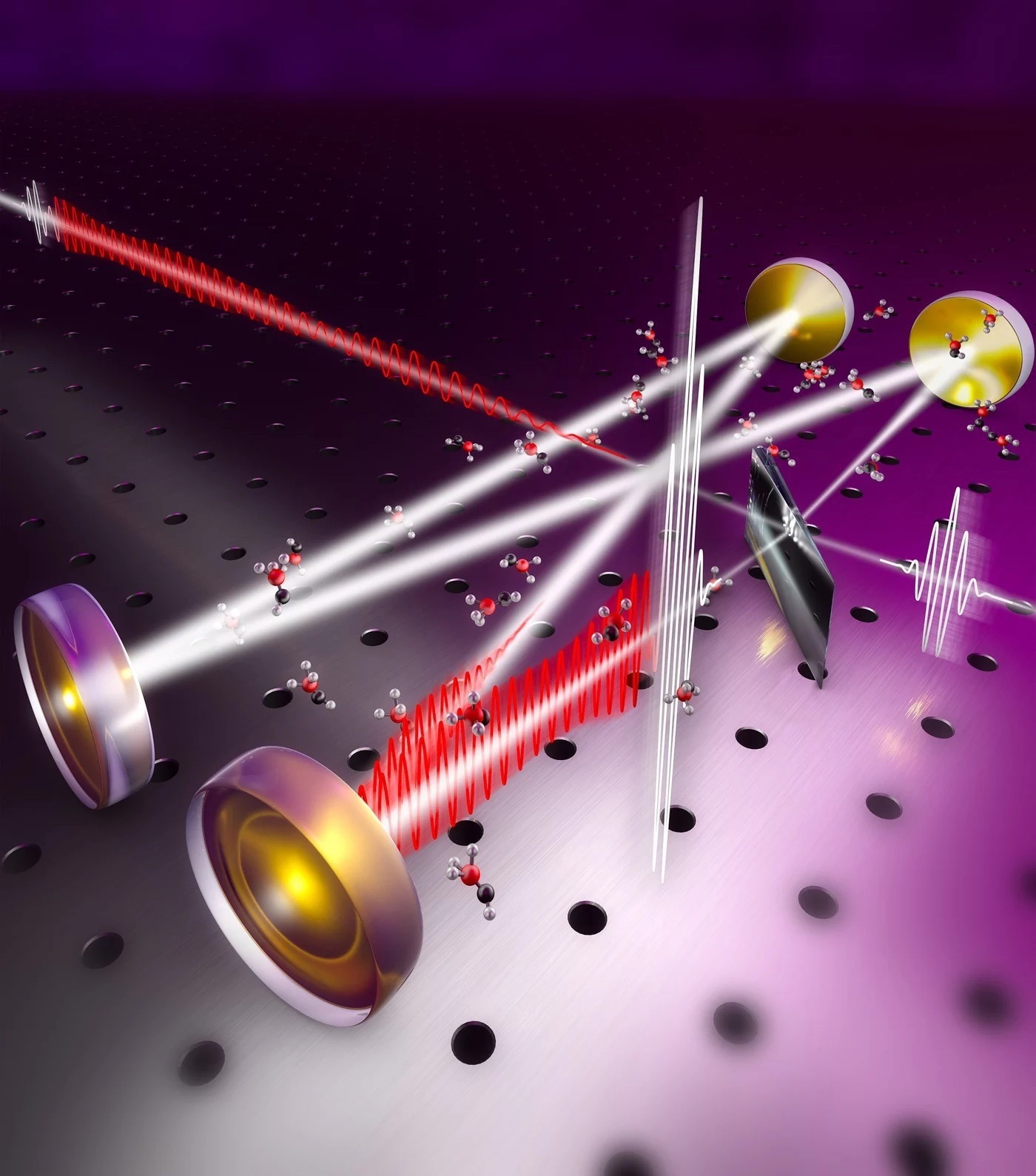Researchers are creating novel methods to detect trace particles in the environment, such as volatile organic chemicals. These methods include advances in optical spectroscopy.

Enhancement of laser pulses (white) and molecular responses (red) in a passive optical resonator. Image Credit: Christian Hackenberger
In partnership with researchers from the University of British Columbia and the Leibniz Institute for Photonic Technologies in Jena, a group of researchers headed by Dr. Ioachim Pupeza at Ludwig-Maximilians-Universität München (LMU) and the Max Planck Institute of Quantum Optics (MPQ) is now illustrating a way to enhance the radiation of molecules.
The radiation shows excitation, dramatically improving the “sense of smell” of molecular laser spectroscopy.
As an analogy, when a performer plucks a guitar string, it starts vibrating and generates a tone with the instrument’s pitch, timbre, and variation. When a gas molecule is “struck” by an ultrashort laser pulse, it absorbs a portion of the energy from the laser pulse. Its atoms start vibrating. Rather than a sound wave, the molecule creates a unique optical waveform that may be identified via spectroscopy.
This waveform offers data on the gas’s molecular makeup. Sadly, this “molecular music” is quite gentle. This is because only a small portion of the energy stored in the pulse is translated into the slowly declining light waves containing this crucial information.
Temporally Overlapping Laser Pulses
Scientists from the attoworld group at MPQ and LMU have discovered a way to enhance molecular responses to reiterating ultrashort laser pulses in the so-called molecular fingerprint spectral region, in partnership with researchers from the University of British Columbia and the Leibniz Institute for Photonic Technologies in Jena. Organic compounds exhibit distinct resonances in the fingerprint spectral region.
To accomplish this, the scientists directed the pulses into a gas-filled optical resonator. The laser pulse beam is steered back into itself within the resonator by numerous mirrors, causing the pulses to periodically overlap with their predecessors and successors. The pulses and molecular responses are amplified as a result.
For the very first time, attoworld laser scientists have coupled out these optical waveforms of amplified molecular reactions from the cavity and recorded them with field-resolved spectroscopy.
A variety of challenges had to be solved before this was achievable.
Until now, passive optical resonators could only cover bandwidths of less than 20% of the central optical frequency and were mostly operated at near-infrared wavelengths.
Philipp Sulzer, Study Lead Author and Physicist, University of British Columbia
“However, to cover a significant portion of the fingerprint range in the mid-infrared, we had to rethink which optical elements and locking mechanisms could be used to build the cavity. In addition, the ultrashort pulses for field-resolved spectroscopy must not change their waveform during one orbit through the resonator,” adds Maximilian Högner, the other leading author of the study.
Ultimately, the laser scientists devised a design that included four gold-coated mirrors, humidity-controlled air, and a wedge-shaped diamond plate to pair light into and out of the resonator. Their method provides a 500-fold increase in the energy stored in the molecular response following impulsive excitation.
Increasing Chances to Reliably Detect Diseases
The new measurement setup combines our previous work on enhancement cavities with our expertise in field-resolved spectroscopy. The results open up perspectives for broadband gas spectroscopy with sensitivities of one to a trillion particles.
Dr Ioachim Pupeza, Ludwig-Maximilians-Universität München
“At the same time, because of the comparatively narrow absorption lines in the gas phase, the technique offers high potential for complex gas mixtures such as human breath, in which some components are present in very high concentrations, but some in very low concentrations,” clarifies Ioachim Pupeza.
Our new approach increases the chances of reliably detecting diseases via human breath in the future and thus providing, for example, new, non-invasive methods for monitoring therapies
Dr Ioachim Pupeza, Ludwig-Maximilians-Universität München
Journal Reference:
Sulzer, P., et al. (2022) Cavity-enhanced field-resolved spectroscopy. Nature Photonics. doi.org/10.1038/s41566-022-01057-0.